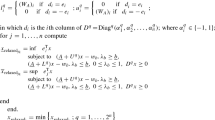Abstract
An operator called CID and an efficient variant 3BCID were proposed in 2007. For the numerical CSP handled by interval methods, these operators compute a partial consistency equivalent to Partition-1-AC for the discrete CSP. In addition to the constraint propagation procedure used to refute a given subproblem, the main two parameters of CID are the number of times the main CID procedure is called and the maximum number of sub-intervals treated by the procedure. The 3BCID operator is state-of-the-art in numerical CSP, but not in constrained global optimization, for which it is generally too costly. This paper proposes an adaptive variant of 3BCID called ACID. The number of variables handled is auto-adapted during the search, the other parameters are fixed and robust to modifications. On a representative sample of instances, ACID appears to work efficiently, both with the HC4 constraint propagation algorithm and with the state-of-the-art Mohc algorithm. Experiments also highlight that it is relevant to auto-adapt only a number of handled variables, instead of a specific set of selected variables. Finally, ACID appears to be the best interval constraint programming operator for solving and optimization, and has been therefore added to the default strategies of the Ibex interval solver.
Similar content being viewed by others
References
Araya, I., Trombettoni, G., Neveu, B. (2010). Exploiting monotonicity in interval constraint propagation. In Proceeding of AAAI (pp. 9–14).
Araya, I., Trombettoni, G., Neveu, B. (2010). Making adaptive an interval constraint propagation algorithm exploiting monotonicity. In Proceedings of CP, Constraint Programming, LNCS 6308 (pp. 61–68). Springer.
Araya, I., Trombettoni, G., Neveu, B. (2012). A Contractor based on convex interval Taylor. In CPAIOR 2012, no. 7298 in LNCS (pp. 1–16).
Balafrej, A., Bessiere, C., Bouyakhf, E., Trombettoni, G. (2014). Adaptive singleton-based consistencies. In AAAI (pp. 2601–2607). AAAI Press.
Benhamou, F., Goualard, F., Granvilliers, L., Puget, J.F. (1999). Revising hull and box consistency. In Proceedings of ICLP (pp. 230–244).
Bennaceur, H., & Affane, M.S. (2001). Partition-k-AC: an efficient filtering technique combining domain partition and arc consistency. In Proceedings of CP (pp. 560–564).
Bessiere, C., & Debruyne, R. (2005). Optimal and suboptimal singleton arc consistency algorithms. In Proceedings of IJCAI (pp. 54–59).
Chabert, G., & Jaulin, L. (2009). Contractor programming. Artificial Intelligence, 173, 1079–1100.
Chabert, G., & Jaulin, L. (2009). Hull consistency under monotonicity. In Proceedings of CP, LNCS 5732 (pp. 188–195).
Debruyne, R., & Bessiere, C. (1997). Some practicable filtering techniques for the constraint satisfaction problem. In Proceedings of IJCAI (pp. 412–417).
Hansen, E. (1992). Global optimization using interval analysis. Marcel Dekker Inc.
Kieffer, M., Jaulin, L., Walter, E., Meizel, D. (2000). Robust autonomous robot localization using interval analysis. Reliable Computing, 3(6), 337–361.
Lebbah, Y., Michel, C., Rueher, M., Daney, D., Merlet, J. (2005). Efficient and safe global constraints for handling numerical constraint systems. SIAM Journal on Numerical Analysis, 42(5), 2076–2097.
Lhomme, O. (1993). Consistency techniques for numeric CSPs. In IJCAI (pp. 232–238).
Mackworth, A. (1977). Consistency in networks of relations. Artificial Intelligence, 8, 99–118.
Merlet, J.P. (2007). Interval analysis and robotics. In Symposium of Robotics Research.
Messine, F. (1997). Méthodes d’optimisation globale basées sur l’analyse d’intervalle pour la résolution des problèmes avec contraintes. Ph.D. thesis, LIMA-IRIT-ENSEEIHT-INPT, Toulouse.
Messine, F. (2002). Extensions of affine arithmetic: application to global optimization. Journal of Universal Computer Science, 8(11), 992–1015.
Messine, F., & Laganouelle, J.L. (1998). Enclosure methods for multivariate differentiable functions and application to global optimization. Journal of Universal Computer Science, 4(6), 589–603.
Min Li, C. (1997). Anbulagan: Heuristics based on unit propagation for satisfiability problems. In Proceedings IJCAI (pp. 366–371).
Tawarmalani, M., & Sahinidis, N.V. (2005). A polyhedral branch-and-cut approach to global optimization. Mathematical Programming, 103(2), 225–249.
Trombettoni, G., Araya, I., Neveu, B., Chabert, G. (2011). Inner regions and interval linearizations for global optimization. In AAAI (pp. 99–104).
Trombettoni, G., & Chabert, G. (2007). Constructive interval disjunction. In Proceedings of CP, LNCS 4741 (pp. 635–650).
Tucker, W. (2002). A rigorous ODE solver and smale’s 14th problem. Foundations of Computational Mathematics, 2, 53–117.
Van Hentenryck, P., Michel, L., Deville, Y. (1997). Numerica : a modeling language for global optimization: MIT Press.
Author information
Authors and Affiliations
Corresponding author
Rights and permissions
About this article
Cite this article
Neveu, B., Trombettoni, G. & Araya, I. Adaptive constructive interval disjunction: algorithms and experiments. Constraints 20, 452–467 (2015). https://doi.org/10.1007/s10601-015-9180-3
Published:
Issue Date:
DOI: https://doi.org/10.1007/s10601-015-9180-3




